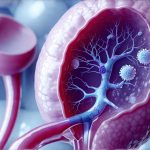Autoimmune kidney disorders represent a complex group of conditions where the body’s immune system mistakenly attacks its own kidneys. This misdirected attack can lead to inflammation, scarring, and ultimately, impaired kidney function. Diagnosing these disorders accurately is crucial for timely intervention and management, as early detection often correlates with better long-term outcomes. Traditional diagnostic methods include blood tests (assessing kidney function and identifying autoantibodies), urine analysis (looking for protein or red blood cells), and sometimes a kidney biopsy – the gold standard but also an invasive procedure. Amidst this diagnostic landscape, ultrasound imaging emerges as a non-invasive tool with potential value, sparking the question: how helpful is a kidney ultrasound in evaluating autoimmune kidney disorders?
This article will delve into the role of kidney ultrasounds in assessing these conditions, exploring its strengths and limitations, and clarifying when it’s most beneficial. We’ll examine what specific findings on an ultrasound might suggest autoimmune involvement, and how it complements other diagnostic tests. It is important to remember that a kidney ultrasound isn’t typically used as a standalone diagnostic tool for autoimmune diseases but rather assists in the overall evaluation process, helping doctors refine their approach and determine further testing needs. Ultimately, understanding its capabilities allows patients and healthcare providers to make informed decisions regarding renal health management.
The Role of Ultrasound Imaging in Kidney Evaluation
Kidney ultrasound utilizes sound waves to create real-time images of the kidneys and surrounding structures. It’s a relatively inexpensive, readily available, and non-invasive imaging technique, making it an attractive initial step in evaluating kidney disease. Unlike other imaging modalities like CT scans or MRIs, ultrasound doesn’t involve ionizing radiation, which is particularly important for patients who may require repeated imaging over time – such as those with chronic autoimmune conditions. The procedure itself is painless and typically takes around 30-60 minutes to perform. It’s also highly operator dependent; the quality of the images can be influenced by the skill and experience of the sonographer performing the scan, and patient factors like body habitus.
While ultrasound excels at visualizing kidney size, shape, and structural abnormalities, it’s less effective at detecting subtle changes associated with early-stage autoimmune disease. It’s more useful for identifying secondary consequences or complications that often arise from these conditions. For example, an ultrasound can easily detect hydronephrosis – swelling of the kidney due to a blockage in urine flow – which might occur as a result of inflammation or scarring caused by an autoimmune process. Similarly, it can identify cysts, tumors, or other structural abnormalities that could mimic or coexist with autoimmune kidney disease. It’s crucial to remember ultrasound provides anatomical information; it doesn’t directly diagnose the cause of the abnormality, only its presence.
Ultrasound is particularly helpful in differentiating between various causes of kidney dysfunction. A normal-sized kidney generally suggests an intrinsic renal problem (originating within the kidney itself), while a small kidney often indicates chronic kidney disease – potentially from long-standing autoimmune damage. Assessing blood flow within the kidneys using Doppler ultrasound can also provide valuable information, though its role in autoimmune kidney disorders is limited and typically reserved for specific situations we’ll discuss later. Ultimately, it serves as an important first step in creating a comprehensive diagnostic picture.
Ultrasound Findings Suggestive of Autoimmune Involvement
Although not definitive, certain findings on a kidney ultrasound might raise suspicion for autoimmune kidney involvement and prompt further investigation. One key indicator is the presence of reduced kidney size, especially if bilateral (affecting both kidneys). This often suggests chronic scarring from prolonged inflammation, which is common in conditions like lupus nephritis or focal segmental glomerulosclerosis (FSGS) triggered by autoimmune processes. However, it’s important to note that small kidneys can also result from other causes such as age-related atrophy or uncontrolled hypertension.
Another finding to watch for is altered kidney echogenicity – essentially, how the sound waves reflect off the kidney tissue. In chronic inflammation, the kidneys may appear more “echogenic” (brighter) than normal due to fibrosis and scarring. Again, this isn’t specific to autoimmune disease but warrants further investigation. The presence of cortical thinning – a reduction in the thickness of the outer layer of the kidney – can also be indicative of chronic damage. It is important to remember that these findings are subtle and require an experienced radiologist or nephrologist to interpret correctly.
- Doppler ultrasound might reveal reduced blood flow within the kidneys, particularly in cases where inflammation has narrowed the renal arteries.
- Ultrasound can help rule out other causes of kidney dysfunction, such as obstruction from kidney stones or tumors.
- The absence of significant abnormalities on ultrasound doesn’t necessarily exclude autoimmune disease; it simply means further testing is needed to establish a diagnosis.
Limitations and Complementary Testing
Despite its utility, kidney ultrasound has considerable limitations in diagnosing autoimmune kidney disorders. Its sensitivity for detecting early stages of glomerular damage – the initial site of attack in many of these conditions – is relatively low. Ultrasound primarily visualizes macroscopic changes; it struggles to detect microscopic inflammation or subtle structural alterations occurring within the glomeruli themselves. This is why kidney biopsy remains the gold standard for diagnosis, providing a definitive assessment of tissue pathology.
Ultrasound also doesn’t provide information about the specific type of autoimmune disease involved. It can identify kidney damage, but it cannot differentiate between lupus nephritis, IgA nephropathy, or other autoimmune-related kidney conditions. Therefore, ultrasound findings must always be interpreted in conjunction with clinical history, physical examination, blood tests (including autoantibody levels), and urine analysis.
To comprehensively evaluate a patient suspected of having an autoimmune kidney disorder, doctors typically employ a tiered approach:
1. Initial assessment with kidney ultrasound to rule out obstruction or other obvious causes.
2. Blood tests to assess kidney function, identify autoantibodies (e.g., anti-dsDNA, ANA), and measure complement levels.
3. Urine analysis to look for protein, red blood cells, and casts.
4. If suspicion remains high, a kidney biopsy is often performed to confirm the diagnosis and determine the specific type of autoimmune disease affecting the kidneys.
When is Kidney Ultrasound Most Helpful?
Kidney ultrasound isn’t typically the first line in diagnosing autoimmune kidney disorders, but it plays a valuable role at various stages of evaluation and management. It’s particularly useful as an initial screening tool to quickly assess kidney size, shape, and overall structure, helping to rule out other causes of kidney dysfunction before proceeding with more invasive tests like biopsy. For example, if ultrasound reveals obstruction due to kidney stones, the focus shifts from autoimmune investigation to stone management.
Ultrasound is also beneficial in monitoring disease progression and response to treatment. Serial ultrasounds can track changes in kidney size or echogenicity over time, providing insights into whether the condition is stabilizing, improving, or worsening. In patients with established autoimmune kidney disease, ultrasound can help detect complications such as hydronephrosis resulting from inflammation or scarring. It’s also useful for guiding renal biopsies – ensuring accurate targeting of the affected area and minimizing risks.
Finally, Doppler ultrasound can be utilized in specific scenarios. Although its role is limited, it may help assess blood flow to identify potential vascular involvement or evaluate the effectiveness of immunosuppressive therapies. However, it’s critical to remember that ultrasound findings should always be interpreted within the broader clinical context, alongside other diagnostic tests and patient information. The key takeaway is that kidney ultrasound is a valuable adjunct to the diagnostic process but rarely stands alone as the definitive answer in autoimmune kidney disorders.





















